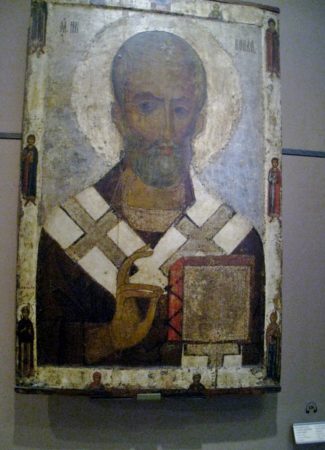By Catherine Tsounis
“Santa Claus is alive! He is St. Nicholas. He gives us hope. Bring children here to see the icon of St. Nicholas,” said Rev. Eugene Pappas, guest speaker at the St. Nicholas of Flushing Vespers Feast Day, December 5th, 2016. New York clergy and residents attended. A reception followed in the Sarantakos Hall, with standing room only. The St. Nicholas Church clergy are Rev. Protopresbyter Paul Palesty; Rev. Presbyter Aristidis Garinis and Rev. Presbyter Joakim Valasiades.
“Santa Claus is always there,” explained Rev Eugene Pappas, ecumenist, educator, missionary and social activist, who serves as pastor at Three Hierarchs Church in Brooklyn for 35 years. “I reach up to him and he reaches down to me. Santa Claus gives us hope.”Father Eugene hosts MATTERS OF CONSCIENCE LIVE ON WNYE 91.5 COSMOS FM, Saturday’s, 1:15 PM.
Rev. Pappas explained “St. Nicholas is a reality. He is in the other world. A little light dispels the darkness and is a door. St. Nicholas or Santa Claus is celebrated throughout the world. I have traveled and everyone celebrated Santa Claus. In Beijing, China, he is celebrated with enthusiasm, even though a communist country. Santa Claus is present”
“Communist Russia celebrated Santa Claus, because he is hope. Rejoice with children and children’s children by St. Nicholas Church. Only know the way if you have roots,” he believes. “We need roots.” The negation of globalism by 2016 government elections reaffirms this belief. Rev. Pappas continued this discussion with this writer, explaining “400 churches are being rebuilt in Russia. They are a suffering church. That is why its faith is blossoming.” I saw with complete amazement intense devotion to the Christian faith on a Russian trip.

Nicolas, Bishop of Myra, has always been the most admired saint, according to the book, “The Russian Icon” by the editorial Board of the Russian Orthodox Church. He prays for all Christians, helps people in misfortunes, protects travelers and quickly defends those to whom injustice has been made. His veneration in Early Russia was almost as great as that of Christ and Mary. Numerous churches were dedicated to St. Nicholas. A large quantity of icons were created in his memory. Russian proverbs show a deep faith in his power.
“The Novgorod State Museum’s collection of early Russian painting is unquestionably one of the finest in the world…Highlights from the earliest period (11th to 13th centuries) include ..St. Nicolas of Myra in Lycia (St. Nicholas of Lipno). These are prototypical images of the 14th and 15th centuries. ‘St. Nicholas of Lipno’ icon painted by Aleksa Petrov in 1294 is the earliest dated Russian icon.1

The detailed investigation of the existence of St. Nicholas of Myra by international scientist Andreas George is the final word on the subject. His scientific examination of sources and historical sites disproves the 1970’s action of the Vatican, demoting St. Nicholas as a major saint or characterization as a mythological figure. St. Nicholas’ ancestors were Greeks, descendants of Alexander the Great’s colonists or of Cretans. The author believes St. Nicholas’ ancestors were most likely from Crete, because of similar customs and traditions with the Greek island. Modern Greek sources on the Greek Cities of Asia Minor show that the Greek communities along the Asia Minor coast had up to 50 percent Cretans until the 1922 Catastrophe. Their dialect and customs were also similar to the Cretan culture. Mr. George’s research added information that St. Nicholas spent time in Cyprus through his visits to monasteries and study of Greek sources.
His translations into English of these facts are invaluable to a serious reader. St. Nicholas’ ancestors were Greeks, descendants of Alexander the Great’s colonists or of Cretans. The author believes St. Nicholas’ ancestors were most likely from Crete, because of similar customs and traditions with the Greek island. Modern Greek sources on the Greek Cities of Asia Minor show that the Greek communities along the Asia Minor coast had up to 50 percent Cretans until the 1922 Catastrophe. Their dialect and customs were also similar to the Cretan culture. Mr. George’s research added information that St. Nicholas spent time in Cyprus through his visits to monasteries and study of Greek sources. His translations into English of these facts are invaluable to a serious reader.2
References:







